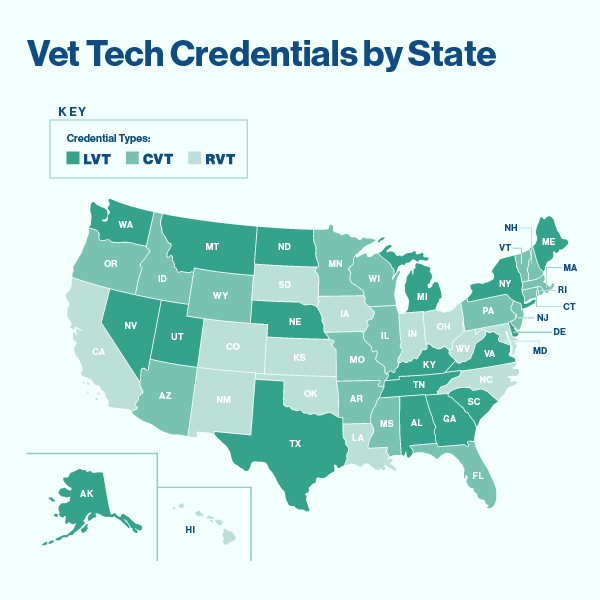
How to Become Certified as a Vet Tech (State by State)
Jul 26, 2023
22 min read
Reviewed by Megan Chadwick, CVT, Director, Penn Foster Veterinary Academy. Learn more about our editorial guidelines.
If you’re interested in becoming a veterinary technician, you’ll most likely need to become certified, licensed, or registered. Every state has different requirements and regulations for what you need to do to be able to work as a vet tech and use the title of veterinary technician, so it’s important to consider that before taking the first steps toward starting a career in the field. To help you figure out what you need to do to become a vet tech in your state, we put together this helpful guide! Learn more about getting certified as a vet tech and check out your state requirements below.
How to get certified as a vet tech
1. Graduate from an AVMA-accredited vet tech program
To become a certified, licensed, or registered veterinary technician, the first step is to enroll in and complete an AVMA-accredited vet tech degree program. Graduating from a program that is accredited through the AVMA is required in almost all states to sit for the Veterinary Technician National Exam (VTNE), which is an essential step toward gaining your credentials. Through your program, you’ll cover both general education requirements, like biology, and vet tech specific skills like animal anatomy and physiology, pharmacology, and surgical nursing.
It’s important to make sure your vet tech school is AVMA-accredited because that ensures that what you’re learning aligns with industry standards.
2. Complete an externship for clinical hours
As part of your vet tech education, you’ll get hands on experience through a required externship. Through your clinical hours, you’ll work under the supervision of a credentialed veterinary technician or licensed veterinarian to apply what you learned in class to real-world situations. In Penn Foster’s online Veterinary Technician Degree Program, you’ll complete your externship hours in two portions: first, after you complete your second semester and then after you finish your fourth semester. The first externship focuses on small animal medicine, where you’ll work with pets like cats, dogs, rodents, and birds. The second externship focuses on large animal medicine, like horses, cows= and other farm animals.
Read more: How to Turn Your Externship Into a Job Offer
3. Pass the Veterinary Technician National Exam (VTNE)
After graduating from your vet tech program and completing all of your externship hours, you’ll prepare to sit for the VTNE. The VTNE is a standardized exam administered by the American Association of Veterinary State Boards (AAVSB). It assesses the knowledge and skills necessary to practice as a veterinary technician. Generally, you’ll need to receive a passing score to apply for state-specific credentials.
4. Meet state-specific requirements
Each state has its own specific requirements for credentialing as a veterinary technician. These requirements could include additional testing, background checks, or specific educational prerequisites, as well as varying application processes. To find out what your state requires, check out the list below!
5. Complete your licensing application
Most states that have regulations around who can work as a vet tech will require an application to gain your credentials. Usually, that will involve paying a fee and submitting your VTNE test scores and vet tech program transcripts. However, each state may have a different process, so you’ll have to follow the guidelines set by the state in which you plan to work.
6. Keep learning
Part of being a veterinary technician is continuous education. Like any medical field, there are always updates and new information to know, so you’ll always be learning in this job. Additionally, to maintain your credentials, most states require you to earn Continuing Education (CE) hours to recertify after a certain time.
Read more: The Difference Between a Veterinary Technician and a Veterinary Technologist
How to get certified, registered, or licensed as a vet tech in each state
Find your state below to learn more about what you need to do to get credentialed to work as a veterinary technician!
How to become a Licensed Veterinary Technician (LVT) in Alabama
In Alabama, veterinary technicians are licensed. Once the license is obtained, they’re officially a Licensed Veterinary Technician (LVT). To become an LVT in Alabama, you need to graduate from an AVMA-accredited veterinary technician program, sit for and pass the VTNE, and then apply to the Alabama State Board of Veterinary Medical Examiners to take your state boards. You’ll need to pass the boards to get your license.
How to become a Licensed Veterinary Technician (LVT) in Alaska
To become a Licensed Veterinary Technician (LVT) in Alaska, you need to graduate from an AVMA-accredited vet tech degree program, pass the VTNE, and apply for your license through the Alaska Board of Veterinary Examiners.
The state also provides another pathway to earning your license: work experience. To meet the requirements for this path, you must have at least two years of on-the-job veterinary technician training under the supervision of a licensed veterinarian. This training must be completed within three years before the date of your license application and at least one of those years must have been done in Alaska.
Your license must be renewed every 2 years to be valid.
Learn about Penn Foster’s AVMA-accredited online vet tech program
Interested in Becoming a Credentialed Vet Tech?

How to become a vet tech in Arizona
Currently, you do not need to be credentialed to be a vet tech in Arizona. However, even though it’s not required, having that credential on your resume can potentially help you stand out when applying for jobs and earn more money. In Arizona, vet techs are certified, so upon earning the credential, you’d be considered a Certified Veterinary Technician (CVT).
To become a CVT in Arizona, you need to graduate from an AVMA-accredited vet tech program, pass the VTNE, and submit an application to the Arizona Veterinary Medical Board. Your certification needs to be renewed every 2 years to be valid.
How to become a Certified Veterinary Technician (CVT) in Arkansas
In Arkansas, those who want to be able toc all themselves certified vet techs are required to be credentialed in order to do the job. This involves graduating from an AVMA-accredited veterinary technician program, passing the VTNE, and applying to the Arkansas Veterinary Medical Examining Board. Arkansas vet techs who successfully complete these steps are considered Certified Veterinary Technicians (CVT).
Certification must be renewed each year to remain valid.
How to become a Registered Veterinary Technician (RVT) in California
To become a veterinary technician in California, and call yourself a Registered Veterinary Technician, you’ll need to graduate from an AVMA-accredited vet tech program, pass the VTNE, complete a federal background check, and submit an application to the California Veterinary Medical Board. Once your application has been reviewed and accepted, you’ll be officially considered a Registered Veterinary Technician (RVT) within the state.
Learn about Penn Foster’s AVMA-accredited online vet tech program
How to become a Registered Veterinary Technician (RVT) in Colorado
Due to new legislation, those who want to practice as a veterinary technician in Colorado must now be registered in order to use the titles Registered Veterinary Technician (RVT) or Veterinary Technician (VT). To be eligible to become an RVT, there are two paths you can take. The first is to graduate from an AVMA-accredited vet tech program, pass the VTNE, and submit your application to the Colorado Association of Certified Veterinary Technicians.
Currently, the second path to becoming an RVT in Colorado involves documented work experience. You must either have 6500+ of verified work experience equivalent to the standard work performed by a veterinary technician, passed the VTNE, and be endorsed by a qualified individual or have 9000+ hours of verified work experience and be endorsed by a qualified individual.
How to become a vet tech in Connecticut
You’re not required to be credentialed to work as a vet tech in Connecticut and the state does not offer voluntary credentialing to veterinary technicians, according to the Connecticut Veterinary Medical Association. However, you can’t call yourself a Certified Veterinary Technician without earning your credentials. Credentialing can be a great way to stand out when you’re applying for jobs, and having credentials on your resume can sometimes even help you earn more money as a vet tech. Even if you don’t pursue voluntary credentials to become a Certified Veterinary Technician (CVT) (which you can find out more about through the Connecticut Veterinary Technician Association), earning an AVMA-accredited Veterinary Technician Associate Degree can help you be better prepared for the job and allow you to stand out to potential employers.
Learn about Penn Foster’s AVMA-accredited online vet tech program
How to become a Licensed Veterinary Technician (LVT) in Delaware
Delaware veterinary technicians are required by the state to be licensed in order to call themselves a Licensed Veterinary Technician. To be eligible to apply for a license and be considered a Licensed Veterinary Technician (LVT), you must graduate from an AVMA-accredited veterinary technician degree program, passed the VTNE, and submitted your application for review through the Delaware Board of Veterinary Medicine. Additionally, veterinary technicians applying to become LVTs must not have any prior criminal record or convictions.
How to become a vet tech in Florida
Vet techs in Florida aren’t required to have certification to work. However, if you’d like to become a Certified Veterinary Technician (CVT) in Florida, you’ll need to graduate from AVMA-accredited vet tech school, pass the VTNE, and apply for certification through the Florida Veterinary Medical Association. Again, while certification isn’t required, it can be helpful to your career. Being a CVT shows potential employers that you know what you’re doing and that you have proven you have the skills to do the job right.
How to become a Licensed Veterinary Technician (LVT) in Georgia
In Georgia, you need to be licensed in order to call yourself a Licensed Veterinary Technician. To get licensed and become a Licensed Veterinary Technician (LVT) in the state, you must have graduated from an AVMA-accredited vet tech degree program and passed the VTNE. Then, you’ll submit your paperwork and application to the Georgia State Board of Veterinary Medicine. Once you’ve successfully completed your application, it will be reviewed by the board and you’ll be notified of their decision. If you’re granted a license, you can officially call yourself an LVT. You must renew your license every 2 years for it to remain valid.
How to become a Registered Veterinary Technician (RVT) in Hawaii
Vet techs in Hawaii cannot call themselves veterinary technicians or Registered Veterinary Technicians (RVT) without first registering with the Hawaii Department of Commerce and Consumer Affairs (DCCA). To be eligible for registration, you need to have graduated from an AVMA-accredited veterinary technician program, passed the VTNE, and submitted your application to the DCCA.
Learn about Penn Foster’s AVMA-accredited online vet tech program
How to become a Certified Veterinary Technician (CVT) in Idaho
You need to be certified to work a veterinary technician in Idaho. To become a Certified Veterinary Technician (CVT), you’ll need to graduate from an AVMA-accredited veterinary technician program, have passed the VTNE, and submit your application through the Idaho Board of Veterinary Medicine.
How to become a Certified Veterinary Technician (CVT) in Illinois
In Illinois, veterinary technicians must be certified in order to use the title Certified Veterinary Technicians. To become a Certified Veterinary Technician (CVT) within the state, you’ll need to have graduated from an AVMA-accredited veterinary technician program, passed the VTNE, and submitted your completed application to the Illinois Department of Financial and Professional Regulation. Once accepted, you’ll officially be considered a CVT and can work within the state. CVTs must renew their certification every other year in order to remain eligible to work in the field.
How to become a Registered Veterinary Technician (RVT) in Indiana
Indiana vet techs need to be registered in order to be called veterinary technicians. To become a Registered Veterinary Technician (RVT), you’ll need to graduate from an AVMA-accredited vet tech degree, have passed the VTNE, submit your application to the Indiana Professional Licensing Association, and pass a criminal background check. You’ll need to renew your registration every 2 years to be a valid RVT.
How to become a vet tech in Iowa
A veterinary technician doesn’t have to be registered to work in Iowa, but registration is recommended to stand out to employers! To become a Registered Veterinary Technician (RVT) in Iowa, you need to graduate from an AVMA-accredited veterinary technician program, pass the VTNE, take the Iowa state exam, and submit your application to the Iowa Board of Veterinary Medicine.
How to become a vet tech in Kansas
Kansas doesn’t require credentials to become a veterinary technician, but registering with the Kansas Board of Veterinary Examiners is recommended to stand out to potential employers and affirm that you have the knowledge and skills to do the job. To become a Registered Veterinary Technician (RVT) in Kansas, you’ll need to graduate from an AVMA-accredited vet tech school, pass the VTNE, submit your registration application to the Kansas Board of Veterinary Examiners, and take and pass their state exam.
Learn about Penn Foster’s AVMA-accredited online vet tech program
How to become a Licensed Veterinary Technician (LVT) in Kentucky
Vet techs who want to work in the state of Kentucky are required to be licensed by the Kentucky Board of Veterinary Examiners. To qualify to become a Licensed Veterinary Technician (LVT), you need to graduate from an AVMA-accredited vet tech program, pass the VTNE, and submit the appropriate documents and application to the Kentucky Board. Once granted a license, LVTs need to renew each year in order to remain eligible to work.
How to become a Registered Veterinary Technician (RVT) in Louisiana
In Louisiana, all veterinary technicians need to be registered with the Louisiana State Board of Veterinary Medicine (LSBVM). To become a Registered Veterinary Technician (RVT), you need to graduate from an AVMA-accredited vet tech school, pass the VTNE, and submit your application, along with two letters of reference from licensed veterinarians to the LSBVM. You’ll also be required to take and pass the state exam, which can be done online or in person.
How to become a Licensed Veterinary Technician (LVT) in Maine
In Maine, you need to be licensed to call yourself a veterinary technician. To become a Licensed Veterinary Technician (LVT), you’ll need to graduate from an AVMA-accredited school, pass the VTNE, and submit an application through the Maine Board of Veterinary Medicine. Your license must be renewed every year to remain active.
Learn about Penn Foster’s AVMA-accredited online vet tech program
How to become a Registered Veterinary Technician (RVT) in Maryland
Vet techs in Maryland are required to be registered. There are two ways to become a Registered Veterinary Technician (RVT) in the state. The first is the traditional path: graduate from an AVMA-accredited veterinary technician degree program, pass the VTNE, and submit your application to the Department of Agriculture.
The second way to become an RVT in Maryland includes holding an associate degree or higher, with a copy of transcripts showing you earned at least three credits in Biology I and II, Microbiology, Chemistry, or Anatomy and Physiology I and II. You’ll also have to submit as skills assessment and proof of at least 10,000 hours of valid work experience in the field, 24 hours of vet tech continuing education, and 24 hours of experience as a veterinary technician in an emergency facility. These are all required to be eligible to sit for the VTNE. Once you’ve sat for and passed the VTNE, you’ll then submit your application.
How to become a vet tech in Massachusetts
Massachusetts doesn’t require that veterinary technicians become certified to work. However, most employers do look to hire vet techs who’ve graduated from a two-year vet tech degree program. While certification isn’t required, becoming a Certified Veterinary Technician (CVT) can help you stand out when applying for jobs and could also allow you to earn a higher salary.
To become a CVT in Massachusetts, you’ll need to graduate from an AVMA-accredited vet tech program, pass the VTNE, and submit an application to the Massachusetts Veterinary Technician Association (MVTA). You’ll need to renew your credential each year for it remain active.
How to become a Licensed Veterinary Technician (LVT) in Michigan
Michigan requires veterinary technicians to be licensed. To become a Licensed Veterinary Technician (LVT) in Michigan, you need to graduate from an AVMA-accredited veterinary technician degree, pass the VTNE, and submit an application to the Michigan Board of Veterinary Medicine.
Learn about Penn Foster’s AVMA-accredited online vet tech program
How to become a Certified Veterinary Technician (CVT) in Minnesota
Minnesota doesn’t require that vet techs be certified or credentialed to work. However, becoming a Certified Veterinary Technician (CVT) in Minnesota can help you stand out when you’re applying for jobs and show employers you have the skills they’re looking for. To become a CVT, you’ll need to graduate from an AVMA-accredited veterinary technician program, pass the VTNE, and submit your application to the Minnesota Veterinary Medical Association (MVMA).
How to become a Certified Veterinary Technician (CVT) in Mississippi
Vet techs in Mississippi need to be certified. To become a Certified Veterinary Technician (CVT) in Mississippi, you need to graduate from an AVMA-accredited vet tech degree program, pass the VTNE, and submit your application to the Mississippi Board of Veterinary Medicine along with 3 letters of recommendation.
How to become a Registered Veterinary Technician (RVT) in Missouri
In Missouri, veterinary technicians need to be registered. To become a Registered Veterinary Technician (RVT) in Missouri, you need to graduate from an AVMA-accredited vet tech school, pass the VTNE, pass the state boards, and submit your application to the Missouri Veterinary Medical Board.
Learn about Penn Foster’s AVMA-accredited online vet tech program
How to become a Licensed Veterinary Technician (LVT) in Montana
Since legislation passed in 2021, veterinary technicians in Montana must now be licensed. Previously, Montana vet techs did not need licensing or credentials. In order to become a Licensed Veterinary Technician (LVT) in Montana, you’ll need to graduate from an AVMA-accredited veterinary technician degree program, sit for and pass the VTNE, and submit your application to the Montana Board of Veterinary Medicine.
How to become a Licensed Veterinary Technician (LVT) in Nebraska
You need to be licensed as a veterinary technician in Nebraska. To become a Licensed Vet Tech (LVT), you’ll need to graduate from an AVMA-accredited veterinary technician degree program, sit for and pass the VTNE, and submit your application to the Nebraska Department of Health and Human Services.
How to become a Licensed Veterinary Technician (LVT) in Nevada
Vet techs in Nevada need to be licensed. To become a Licensed Veterinary Technician (LVT), you’ll need to graduate from an AVMA-accredited vet tech school, sit for and pass the VTNE, and apply to the Nevada Veterinary Medical Association.
Learn about Penn Foster’s AVMA-accredited online vet tech program
How to become a vet tech in New Hampshire
Veterinary technicians in New Hampshire aren’t required to be certified to work in the field. However, becoming a Certified Veterinary Technician (CVT) can offer many career benefits, including helping you stand out to employers when applying for jobs! To become a CVT in New Hampshire, you need to graduate from an AVMA-accredited veterinary technician program, sit for and pass the VTNE, and submit your application to the New Hampshire Veterinary Technician Association.
How to become a vet tech in New Jersey
New Jersey doesn’t currently require veterinary technicians to have certification to work. Certification, however, can be a great way to show potential employers you have the skills they’re looking for! Like in other states, to become a Certified Veterinary Technician (CVT) in New Jersey, you’ll need to graduate from an AVMA-accredited vet tech school, pass the VTNE, and submit an application to New Jersey Veterinary Technicians and Assistants.
How to become a Registered Veterinary Technician (RVT) in New Mexico
You must be a Registered Veterinary Technician (RVT) in the state of New Mexico. In order to become an RVT, you’ll need to graduate from an AVMA-accredited veterinary technician degree program, pass the VTNE, and submit your application to the New Mexico Board of Veterinary Medicine.
How to become a Licensed Veterinary Technician (LVT) in New York
You must be a Licensed Veterinary Technician (LVT) in New York. To become an LVT in New York, you’ll need to graduate from an AVMA-accredited veterinary technician program, pass the VTNE, and submit your application to the New York State Education Department.
Learn about Penn Foster’s AVMA-accredited online vet tech program
How to become a Registered Veterinary Technician (RVT) in North Carolina
In North Carolina, you must be a Registered Veterinary Technician (RVT) to work. To become an RVT in North Carolina, you need to graduate from an AVMA-accredited vet tech program, pass the VTNE, submit your application to the North Carolina Veterinary Medical Board, and pass the North Carolina Veterinary Technician State Exam.
How to become a Licensed Veterinary Technician (LVT) in North Dakota
North Dakota veterinary technicians must be licensed. To become a Licensed Veterinary Technician (LVT) in North Dakota, you’ll need to graduate from an AVMA-accredited vet tech school, pass the VTNE, and submit your application to the North Dakota Board of Veterinary Medical Examiners.
How to become a Registered Veterinary Technician (RVT) in Ohio
To work as a vet tech in Ohio, you’ll need to be registered. To become a Registered Veterinary Technician (RVT), you’ll need to graduate from an AVMA-accredited vet tech degree program, pass the VTNE, and submit your application to the Ohio Veterinary Medicine Licensing Board.
Learn about Penn Foster’s AVMA-accredited online vet tech program
How to become a Registered Veterinary Technician (RVT) in Oklahoma
You must be a Registered Veterinary Technician (RVT) in Oklahoma. To become an RVT in the state, you must graduate from an AVMA-accredited veterinary tech program, pass the VTNE, and submit your application to the Oklahoma Veterinary Board.
How to become a Certified Veterinary Technician (CVT) in Oregon
You need to be certified in Oregon to call yourself a veterinary technician. To become a Certified Veterinary Technician (CVT) in the state, you need to graduate from an AVMA-accredited vet tech program, pass the VTNE, and submit an application to the Oregon Veterinary Medical Examining Board.
How to become a Certified Veterinary Technician (CVT) in Pennsylvania
In Pennsylvania, you need to be certified to be able to use the title veterinary technician. Like other states, to become a Certified Veterinary Technician (CVT), you’ll need to graduate from an AVMA-accredited vet tech degree program, pass the VTNE, and submit your application to the PA State Board of Veterinary Medicine.
How to become a vet tech in Rhode Island
Right now, Rhode Island has no formal requirement for veterinary technicians, so you don’t have to necessarily be credentialed to work. However, having credentials on your resume can help you stand out to employers and can even potentially help you earn more when you’re starting out. To become a Certified Veterinary Technician (CVT) in Rhode Island, you’ll need to graduate from an AVMA-accredited veterinary technician degree program, pass the VTNE, and submit an application to the Rhode Island Veterinary Technician Association.
Learn about Penn Foster’s AVMA-accredited online vet tech program
How to become a Licensed Veterinary Technician (LVT) in South Carolina
You must be a Licensed Veterinary Technician (LVT) in South Carolina. To become an LVT in the state, you’ll need to graduate from an AVMA-accredited vet tech program, pass the VTNE, and submit an application to the South Carolina Board of Veterinary Medical Examiners.
How to become a Registered Veterinary Technician (RVT) in South Dakota
South Dakota requires that all veterinary technicians be registered. To become a Registered Veterinary Technician (RVT), you’ll need to graduate from an AVMA-accredited veterinary technician school, pass the VTNE, and submit your application to the South Dakota Board of Veterinary Medical Examiners.
How to become a Licensed Veterinary Technician (LVT) in Tennessee
You must be a Licensed Veterinary Technician (LVT) in Tennessee. To become an LVT in the state, you’ll need to graduate from an AVMA-accredited veterinary technician degree program, pass the VTNE, and submit your application to the Tennessee Board of Veterinary Medical Examiners.
Learn about Penn Foster’s AVMA-accredited online vet tech program
How to become a vet tech in Texas
Texas doesn’t require licensing for veterinary technicians to work, but you can’t call yourself a Licensed Veterinary Technician (LVT) without becoming credentialed. To become an LVT in Texas, you’ll need to graduate from an AVMA-accredited veterinary technician program, pass the VTNE, pass the Texas Licensed Vet Tech Exam (TLVTE), and submit an application to the Texas Board of Veterinary Examiners.
How to become a vet tech in Utah
Utah currently doesn’t have any licensing or credentialing requirements in place for veterinary technicians. However, even though it’s not required to work, becoming a Licensed Veterinary Technician (LVT) can be beneficial when you’re applying for jobs and allow you to stand out from other applicants. To become an LVT in Utah, you’ll need to graduate from an AVMA-accredited vet tech program, pass the VTNE, and submit an application to the Utah Division of Professional Licensing.
Alternatively, if you haven’t graduated from an AVMA-accredited program but have completed at least 6,000 hours of supervised practice under a licensed veterinarian, you can submit a verification of experience form with your application.
How to become a vet tech in Vermont
Vermont doesn’t currently require vet techs to be credentialed in order to work in the field. However, becoming a Certified Veterinary Technician (CVT) can be a great way to increase your chances of being hired and even potentially allow you to qualify for a higher starting salary. To become a CVT in Vermont, you’ll need to graduate from an AVMA-accredited veterinary technician program, pass the VTNE, and submit your application to the Vermont Veterinary Technicians Association.
Learn about Penn Foster’s AVMA-accredited online vet tech program
How to become a Licensed Veterinary Technician (LVT) in Virginia
In Virginia, veterinary technicians are required to be licensed. To become a Licensed Veterinary Technician (LVT), you’ll need to graduate from an AVMA-accredited veterinary technician program, pass the VTNE, and submit your application to the Virginia Board of Veterinary Medicine.
How to become a Licensed Veterinary Technician (LVT) in Washington
In Washington, you need to be licensed to work as a veterinary technician. To become a Licensed Veterinary Technician (LVT) in Washington, you’ll need to graduate from an AVMA-accredited vet tech school, pass the VTNE, pass the Washington State Jurisprudence Examination, and submit your application to the Washington State Department of Health.
Alternatively, if you didn’t graduate from an AVMA-accredited program but did graduate from a two-year program in animal health or veterinary technology and have a minimum of 36 months of full-time experience under the supervision of one or more licensed veterinarians, as well as passed the VTNE, you may apply for licensure with the state.
Learn about Penn Foster’s AVMA-accredited online vet tech program
How to become a Registered Veterinary Technician (RVT) in West Virginia
In West Virginia, you must be a Registered Veterinary Technician (RVT) to work in the field. To become an RVT in the state, you’ll need to graduate from an AVMA-accredited veterinary technician program, pass the VTNE, pass the West Virginia Jurisprudence Exam, and submit your application to the West Virginia Board of Veterinary Medicine.
How to become a Certified Veterinary Technician (CVT) in Wisconsin
Wisconsin requires that all working vet techs be certified. To become a Certified Veterinary Technician (CVT) in the state, you need to graduate from an AVMA-accredited veterinary technician program, pass the VTNE, pass your Wisconsin state exam, and submit your application through the Wisconsin Veterinary Examining Board.
How to become a vet tech in Wyoming
Veterinary technicians in Wyoming do not need to be certified to work in the state. But even though certification is voluntary, becoming credentialed can be a great way to stand out when you’re applying for jobs. To become a Certified Veterinary Technician (CVT) in Wyoming, you’ll need to graduate from an AVMA-accredited vet tech school, pass the VTNE, be a member of the Wyoming Veterinary Technician Association, and submit your application through them.
Other vet tech requirements
Besides earning your degree and passing any necessary exams, different states may have additional requirements to meet to qualify for credentialing. These can include things like submitting letters of recommendation from veterinarians you’ve worked with, criminal and federal background checks, or verification of citizenship.
Further, once you’ve become certified, licensed, or registered as a vet tech in your state, you’ll need to maintain your credentials. Each state has different requirements and timelines for renewing your credentials, but most include taking a certain number of approved continuing education hours. Generally, this will happen every year or every other year, but make sure to check with your state for specific renewal requirements.
Finding an AVMA-accredited veterinary technician program
Since graduation from an AVMA-accredited program is required to take the VTNE in almost all cases and passing the VTNE is a requirement for credentialing in all states, it’s important that you find the right vet tech program to help you meet your goals. When you’re searching out veterinary technician training programs, make sure to verify that the program has the necessary accreditation before enrolling.
While the job of a veterinary technician is very hands on, you don’t necessarily need to focus on finding an on-campus vet tech degree. If the program you’re looking at is AVMA-accredited, you’ll also complete required externship hours. That means, as part of your degree, you’ll have to complete hands-on training at a local vet clinic or hospital near you, under the supervision of a licensed veterinarian or credentialed veterinary technician.
Penn Foster’s Veterinary Technician Associate Degree, for example, is completely online, self-paced, and AVMA-accredited. That allows you to pursue your training, prepare to sit for the VTNE and meet state requirements for credentialing, and still continue to work and live your life.
To learn more about how an online vet tech degree works or what you need to do to get started, request more information or reach out to our Admissions Specialists today at 1-888-427-6500!





